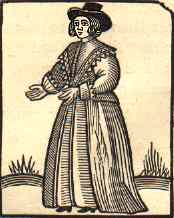The Puritans attack
Most Puritans with offices in the Church accepted outward conformity to prevent their positions falling to Catholics; but they thus compromised themselves, dividing Puritan ranks. Controversy began after the failure of moderate attempts at reform through Parliament; conflict escalated to more fundamental criticisms of church government, doctrine, and perceived abuses. An organized pamphlet campaign* was conducted by John Field, who became the London head of a loose federation of Presbyterian* assemblies.
Focusing their attack on church corruption such as simony and pluralism*, the Puritans gained popular support, as well as the patronage of influential laymen only too happy to undermine the arbitrary powers of bishops and ecclesiastical courts*. With the support of patrons such as Lord Burghley* and the Earl of Leicester, Puritans were largely protected from the increasingly reactionary measures of the Church (and Elizabeth).
Footnotes
-
Another pamphlet war
The first and second "Admonition of Parliament," written by Field, were classic criticisms of the Established Church and gained wide support for Puritans from people who only shared a desire for the disciplining of corrupt ministers: "such [ministers] seeke not the Lord Jesus, but theyr own bellies, clouds they are withoute frute, painted sepulchres full of dead bones." Even royal supremacy was questioned by the argument "Christ onelie and not the godlie Magistrate must appoint what is necessarie for his Ministers."
-
The Presbyterians
Presbyterianism was Calvinist in origin and was the system of church government used by the Church of Scotland founded in 1559 by John Knox. Presbyters (elders) were elected by the congregation to serve as their ministers and meet at assemblies, which governed the Church as a whole. Religious government was independent from secular politics.
-
Pluralism
"[The minister] posteth it over, as fast as he can gallop. For either he hathe two places to serve, or else there are some games to be playde in the afternoone, as. . .heathnishe dauncing for the ring, a beare or a bull to be baited, or else. . .an enterlude to be plaide." The practices of simony (buying and selling church offices) and pluralism were ancient in origin.
-
Defending common law
Lawyers in particular resented the Church courts, as their inquisitional practices were against the traditions of common law and smacked of Catholic Counter-Reformation.
-
Burghley and Leicester
Burghley and Leicester were Privy Councillors, and were also Chancellors of the universities of Cambridge and Oxford. Under Burghley's protection, Cambridge especially became a training ground for Puritans, helping to spread their beliefs among the wealthy classes.
-
The empire strikes back
The appointment of John Whitgift as Archbishop of Canterbury in 1583 was a major turning point for the Elizabethan Church. He led a strong counter-attack against the Puritans, and with the death of John Field in 1588 their tenuous confederation crumbled.
Until the reign of James I, the Puritan movement for reform became focused upon individual piety, education and preaching. Continued persecution led a group of separatist Pilgrims to emigrate to America in 1620 (on board the Mayflower); others moved to Europe. However, remaining Puritans continued to work within Parliament, where their fortunes improved as Parliament increasingly asserted its rights against the absolutist claims of James and his son, Charles I.
